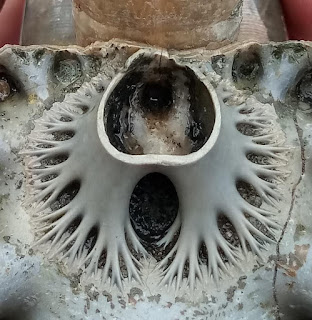 |
| Dr. David Evans, Hadrosaurs & Ornithomimids |
Join us for a VIPS Zoom Lecture with Dr. David Evans to learn about dinosaur discoveries on Vancouver Island.
A Hadrosauroid dinosaur is a rare occurrence and further evidence of the terrestrial influence in the Upper Cretaceous, Nanaimo Group, Vancouver Island — outcrops that we traditionally thought of as marine from years of collecting well-preserved marine fossil fauna.
The fossil bone material was found years ago by Mike Trask of the Vancouver Island Palaeontological Society. You may recall that he was the same fellow who found the Courtenay Elasmosaur on the Puntledge River.
Mike was leading a fossil expedition on the Trent River. While searching through the Upper Cretaceous shales, the group found an articulated mass of bones that looked quite promising.
Given the history of the finds in the area, the bones were thought to be from a marine reptile.
In 2016, after years of collecting dust and praise in equal measure, the bones were reexamined. They didn't quite match what we'd expect from a marine reptile. Shino Sugimoto, Fossil Preparator, Vertebrate Palaeontology Technician at the Royal Ontario Museum was called in to work her magic — painstakingly prepping out each caudal vertebrae from the block.
Once fully prepped, seemingly unlikely, they turned out to be from a terrestrial hadrosauroid. This is the second confirmed dinosaur from the Upper Cretaceous Nanaimo Group. The first being a theropod from Sucia Island consisting of a partial left thigh bone — the first dinosaur fossil ever found in Washington state.
ABOUT DAVID EVANS
Dr. David C. Evans holds the Temerty Chair in Vertebrate Palaeontology and oversees dinosaur research at the Royal Ontario Museum (ROM). He is also an Associate Professor in the Department of Ecology and Evolutionary Biology at the University of Toronto.
David is an Ontario-born researcher who is recognized globally as an authority on the rich dinosaur fossil record of Canada, and on the mass extinction event that marked the end of the Age of Dinosaurs. As a curator, David helped develop the ROM's dinosaur galleries and was Lead Curator of the major travelling exhibition Ultimate Dinosaurs. He has been featured on numerous television shows, and most recently, David was co-creator of the HISTORY series Dino Hunt Canada.
David’s research focuses on the evolution, ecology and diversity of dinosaurs, and their relationship to environmental changes leading up to the end-Cretaceous mass extinction event.
Active in the field, he has participated in expeditions all over the world, including Africa, Mongolia, and Canada, and has helped discover 10 new dinosaur species in the last five years- including the remarkable horned dinosaur Wendiceratops from southern Alberta, and the wickedly armoured Zuul named after the Ghostbusters movie monster.
This VIPS talk is free to the public. No registration is required. To participate, head to www.fossiltalksandfieldtrips.com and click the link to enter the Zoom meeting. The link will be live on the day of the talk.


%20Fram%20Formation%20of%20Nunavut,%20Canada.%20The%20genus%20contains%20a%20single%20species,%20Q.%20wakei,%20known%20from%20a%20partial%20skele.png)

.png)


.jpg)



























